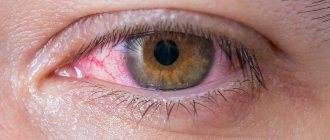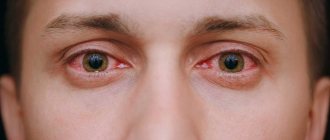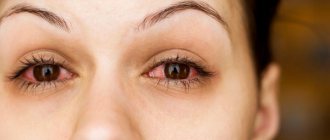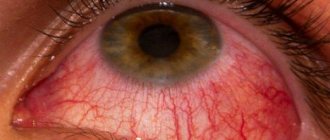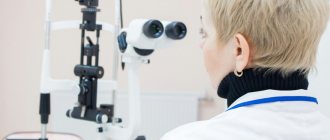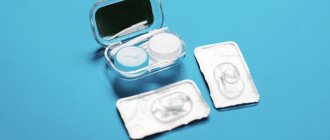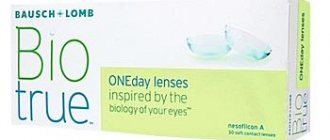In the last decade, dry eye syndrome has become increasingly common - one of the main causes of chronic eye irritation and inflammation of the conjunctival vessels. In this article we will talk about the main causes of this disease, its symptoms and treatment methods.
Often, a painful sensation of dryness occurs when the cornea is insufficiently hydrated. It is called dry eye syndrome, and ophthalmologists call the disease keratitis sicca.
Dry eyes are also a common complaint among many contact lens users. In such cases, it is necessary to additionally use moisturizing drops or ointments. Without them, it will simply be impossible to continue using contact correction products.
Causes of dryness when using lenses
Dryness develops when there is decreased tear production and insufficient surface hydration.
The result is the sensitivity of the organ of vision to air, wind and smoke. Causes pain, discomfort and a feeling of a foreign body in the eye.
The eyes begin to dry out for the following reasons:
- poor quality or contaminated solution;
- insufficient hygiene;
- wearing products for more than 10 hours (if they are daytime);
- malnutrition;
- individual intolerance to the selected product;
- dry indoor air;
- change in the component of tear fluid due to menopause;
- exacerbation after laser correction;
- use of antidepressants and oral contraceptives;
- diabetes mellitus or blepharitis.
All these cases are accompanied by insufficient hydration of the cornea. If the composition of the tear fluid is disrupted, this also affects the condition of the cornea, it dries out and becomes more sensitive.
Timely hydration
Allergens present in the environment also cause dryness. This symptom also appears when the cornea is insufficiently hydrated.
Prompt cleaning of contact lenses and the use of eye drops help eliminate the problem.
Moistening of the cornea is carried out if necessary. Drops should be carried with you at all times if the user suffers from dryness even in good, non-windy weather. Albucid, Taufon, Solcoseryl, Lecrolin drops are suitable. Use according to instructions, instill no more than 1-2 drops at a time.
At night, remove the lenses, clean them and place them in a multifunctional solution. It is important to change the fluid daily. Use Aosept Plus once a week. The solution, similar in composition to tears, perfectly moisturizes the lens within 6 hours.
An excellent moisturizer for daily use in conjunction with contact lenses are drops based on hyaluronic acid - Okutiarz. Okutiarz drops quickly eliminate dryness and discomfort in the eyes and protect the surface of the eye throughout the day. The shelf life of the drops is 6 months from the moment the bottle is opened. Apply 1 drop in each eye 1-4 times a day, or as needed.
In case of intense dryness and discomfort in the eyes, which bother you from the moment you wake up, a unique cationic emulsion developed in Japan - Cationorm - will help. Cationorm moisturizing drops do not contain preservatives and can be applied directly to lenses. In addition to long-term hydration, Cationorm restores all layers of tears and prevents the further development of dry eye syndrome. The recommended dose is 1 drop in each eye 1-4 times a day.
Eye lenses resistant to dehydration.
Today there is a large selection of contact optics, which are specially designed for people whose eyes are exposed to heavy visual stress, exposure to adverse factors and, therefore, need increased protection from dryness. Such eye lenses are made from modern materials with good hydrophilicity. They are capable of not only attracting moisture, but also retaining it on the surface of the optical product. An example of such lenses is ACUVUE OASYS. They use a special technology called Hydraclea Plus, which activates the functions of the tear film, protects the eyes from moisture loss and provides high user comfort. Another option that is suitable for people with dry eye syndrome is Dailies Total 1 lenses. They are created using a unique water-gradient technology and contain almost 100% water on the surface. If you wear such lenses, your eyes feel comfortable for up to 16 hours.
You can always purchase hydrophilic lenses, care products and moisturizing drops at a competitive price in our online store.
What to do if you have persistent dry eyes
If the organs of vision are constantly dry, you should reconsider the mode of wearing contact lenses and the correctness of hygiene measures before removing and putting on the products. For users who frequently complain of dry eye syndrome, it is recommended to use silicone hydrogel lenses.
The moisture content and oxygen permeability in optics made from this material are increased.
Thanks to the passage of oxygen, the tear film functions properly.
It is equally important to use moisturizing drops. The best medications are those containing sodium hyaluronate.
Traditional healers advise washing the mucous membranes of the eyes with weak brewed black tea or cooled decoctions of chamomile and lemon balm. Make lotions from the decoctions for 10–20 minutes.
Symptoms
Despite the different manifestations of dry eye syndrome that patients describe when visiting an ophthalmologist, many of them report dryness when wearing eye lenses. The most common of them include:
- foreign body sensation, irritation, burning;
- blurred picture and blurred vision by the end of the day;
- redness;
- increased photosensitivity;
- discomfort when wearing contact lenses.
Even the presence of one of the symptoms may indicate keratoconjunctivitis sicca. The Schirmer and Jones tests, Norma and West tests will help to accurately determine the diagnosis. For example, during the Schirmer test, the doctor inserts a narrow paper strip under the patient's lower eyelid and leaves it for a while. Then, based on the level of wetting, it judges the sufficiency of tear fluid. Using these tests, two main indicators of eye hydration are measured: the level of tear production and the level of tear removal.
Complications
The development of dryness and continued wearing of contact lenses has serious consequences.
In advanced cases, dry eye syndrome leads to the following complications:
- conjunctival xerosis;
- dry keratoconjunctivitis;
- filamentous keratitis;
- corneal erosions and ulcers.
The eyes do not tolerate being treated frivolously. Dryness leads to consequences that cannot be eliminated every second. These complications will require long-term, complex and expensive treatment.
Why does the situation not change if all recommendations are followed?
If, despite all preventive measures, you cannot get rid of corneal dryness, then you need to pay more attention to your vision:
- Visit your ophthalmologist regularly to select the correct size and brand of optical product and monitor the condition of the cornea to prevent complications.
- Consult other medical specialists. Possibly, insufficient eye hydration is caused by endocrine or neurological disorders.
- Wash your hands and face often with cold water after removing your lenses. This will reduce irritation and remove the feeling of “sand” in the eyes.
Dry eye syndrome when using contact correction products is more common in young people who spend a lot of time looking at a computer screen. By following measures to prevent corneal dryness and eliminating the first symptoms in a timely manner, you can use contact correction products without unnecessary inconvenience.
Prevention
When purchasing contact optics, a specialist will determine errors in vision and explain how to properly store, care and wear. He will also tell you how to avoid dry eyes and what to do about it.
Prevention consists of sufficient use of a cleaning solution, liquid and disinfection tablets once a week. Contact lenses cannot be removed with your fingernails; special tweezers are used for this.
Do not leave the container open, the lenses without solution. This leads to their rapid drying out and, accordingly, the development of discomfort while wearing.
To prevent dryness, it is necessary to humidify the room in winter and summer, and use sunglasses if the contact optics are not protected by a UV filter.
What to do if your cornea is dry?
When the first symptoms of corneal dryness appear, it is necessary to eliminate all possible causes of this condition:
- selection of appropriately sized lenses made of hypoallergenic material;
- regular replacement of optical correction devices and adherence to the recommended wearing regimen;
- regular change of disinfectant solution;
- choosing a high-quality and suitable solution to prevent premature drying of optical products;
- the use of moisturizing drops to prevent the development of dry eye syndrome.
Signs of dry eye syndrome in contact lens users
When a person blinks, the tear fluid is distributed evenly, forming a specific film.
It performs several functions at once: it washes away dust and foreign particles from the conjunctival cavity, saturates the cornea with oxygen, moisturizes it, making the blinking process more comfortable, etc. This process may be disrupted as a result of changes in the structure of the tear fluid or its lack. In this case, the sensitivity of the cornea to external stimuli increases, which can lead to many complications.
Contact lens wearers may experience the following unpleasant symptoms of dry eye syndrome:
- constant sensation of a foreign body;
- unclear picture;
- redness and increased fatigue of the eyes;
- feeling of "sand".
Due to discomfort, many people switch to glasses, but in vain. With proper treatment, you can get rid of dry eye disease without changing your habits.
Why does the eyelid twitch when wearing lenses?
Lenses can cause microtrauma to the cornea and eyelids, causing eyelid twitching. This occurs either due to improper operation, if the optical product is selected incorrectly, or its service life has expired. Twitching often occurs if the lenses have a radius of curvature that differs from the radius of curvature of the eyes. Only an ophthalmologist can correctly determine this parameter. He will prescribe lenses that will be ideal for you. If you suffer from dry eyes, then Acuvue Oasys includes optical products with a base curvature of 8.4 and 8.8 - the most common among the population. An ophthalmologist will tell you which ones are right for you.
CONTACT LENSES AND DRY EYE SYNDROME
04.06.2017
The feeling of dry eyes is a very common problem that affects up to a third of the entire population. The development of such symptoms is associated with a number of additional factors, which include advanced age, belonging to the weaker sex, allergies, working at a computer, hormone levels and taking certain medications. And, alas, another factor that sharply increases the risk of developing dry eye syndrome (DES) is still wearing contact lenses (CL). Wearing contact lenses can cause unpleasant symptoms similar to those experienced by people who suffer from dry eye syndrome without contact lenses. In the United States alone, out of 35 million CL users, almost 18 million people complain of a feeling of dry eyes. But, despite the similarity of symptoms, many experts believe that dry eye syndrome caused by wearing CL requires special diagnosis and a special approach to treatment. This is reflected in the dry eye classification developed in 2007 by the international organization Dry Eye WorkShop (DEWS). In recent years, special questionnaires and questionnaires have been developed and tested abroad to identify symptoms of dry eye syndrome in people wearing CL. Data to date shows that CL wearers report symptoms of dryness 12 times more often than emmetropes, and approximately 5 times more often than glasses wearers! According to some estimates, in this regard, approximately 50% of CL users express dissatisfaction with the chosen means of optical correction, and 24% stop wearing CL for a long time or permanently. When wearing contact lenses, the following negative symptoms are possible: discomfort, a feeling of dryness, a feeling of a lens on the eye, redness of the eyes, irritation and increased sensitivity of the eyes, burning and “sand”, itching, blurred vision, visual fatigue. Studies conducted among former CL users showed that dryness and discomfort were the main reasons for abandoning this means of optical correction. It appears that it is very important to understand the reasons for this phenomenon in order to effectively manage such patients and reduce the number of refusals. Of significant interest is determining the role of lens material, wetting agents and solutions in the development of dry eye syndrome. Let's look at the various factors that can cause symptoms of dryness in CL users. Factors associated with contact lens material Moisture content and ionicity of the material According to the official classification of the American organization FDA (Food and Drug Administration), materials for soft contact lenses are divided into 4 groups based on charge and moisture content: • 1st group - non-ionic material with low moisture content; • 2nd group – non-ionic material with high moisture content; • 3rd group – ionic material with low moisture content; • 4th group – ionic material with high moisture content. This FDA classification allows a very accurate prediction of the development of dryness symptoms when wearing SCLs made of appropriate materials. When wearing SCLs made from materials of the 2nd and 4th groups, symptoms of dry eye syndrome develop 2–3 times more often compared to SCLs made from materials of the 1st Group. In turn, materials of the 2nd group are more often associated with the development of DES than materials of the 4th group. Efron and Brennan found back in 1988 that patients wearing low-water content contact lenses generally did not complain of dry eyes because these lenses were less susceptible to dehydration than high-water content lenses. Thus, it is clear that with lower moisture content the risk of dry eye disease decreases. Interestingly, most silicone hydrogel materials according to the FDA classification belong to group 1. Dehydration of contact lenses on the eye So, presumably, one of the important factors in the development of dry eye syndrome when wearing contact lenses is dehydration of lenses. Subjective symptoms of dryness are more common among SCL wearers whose lenses are more susceptible to dehydration during daytime wear—and these are lenses with a high moisture content. Potential causes of discomfort in this case are the following: 1) the wettability of the front surface of the lens decreases; 2) this leads to stronger interaction between the eyelids and the lens; 3) in turn, constant friction of the upper eyelid on the lens can lead to displacement of the latter; 4) finally, staining of the cornea is possible due to the evaporation of moisture and drying out of the lens. All hydrogel materials lose moisture during wear. The rate of dehydration depends on many factors - environmental conditions, air humidity, moisture content of the lens and wearing time. Traditional hydrogel materials dehydrate more than silicone hydrogel materials. Already 10 years ago, it was found that dehydration affects not only wearing comfort: it reduces oxygen permeability and deforms the lens, and this leads to changes in optical parameters. Despite all this, the question of a direct connection between lens drying and discomfort during wear remains controversial. A number of similar studies failed to establish such a direct relationship. What we can say for sure is that dehydration-resistant materials such as omafilcon A, hioxifilcon A and hioxifilcon D do provide greater comfort. One way or another, we still don’t know everything about the relationship between dehydration and discomfort. Deposits Once put on, SCLs quickly absorb components of the tear film, especially proteins, lipids and mucins. When the level of such deposits becomes high enough, they reduce visual acuity, cause dryness and discomfort, inflammation of the eyelids and papillary conjunctivitis. The amount of deposits varies depending on the SCL material. This means that the wettability of the surface, the stability of the tear film, and the subjective feeling of wearing comfort vary. Materials with high moisture content are characterized by high levels of deposits. FDA Group 2 materials are particularly susceptible to lipid deposits, while Group 4 materials attract more proteins than lipids. Subsequently, some of these proteins - for example, lysozyme - are firmly absorbed into the lens material, undergo structural changes and are denatured. The clinical significance of denatured protein on the surface of hydrogel SCLs is due to the fact that it causes inflammation of the eyelids and thus directly affects comfort. Protein denaturation has previously been shown to be closely associated with inflammatory reactions, including giant papillary conjunctivitis. In addition to this, the latest research has shown that protein denaturation can affect comfort even after a short time of wearing contact lenses, and the total amount of protein and the proportion of lysozyme do not play a special role. Therefore, it is very important that users thoroughly disinfect and clean lenses and adhere to wear and replacement regimens. In addition, doctors should recommend that their patients use special drops that re-moisten the contact lenses and thus prevent the decomposition of protein on the surface of the lenses. The fact is that the process of protein denaturation in sediments will most likely begin on the hydrophobic surface. Wettability (hydrophilicity) of contact lenses It is generally accepted that the comfort of wearing contact lenses directly depends on how well the tear film envelops the surface of the lenses and is retained on it. This surface layer acts as a lubricant, reducing the interaction between the lens and the eyelids. All hydrogel SCLs are characterized by a gradual decrease in wettability and comfort while wearing. In this regard, SCLs with frequent scheduled replacement (both hydrogel and silicone hydrogel) are more convenient than traditional ones: there are fewer subjective complaints from patients and fewer clinical complications. This may be due to less deposits on the front surface of the lenses while maintaining normal wettability. If the tear film that envelops the lens immediately after putting it on plays a positive role, then subsequent deposits from it only play a negative role. As already mentioned, denatured protein or lipids reduce the wettability of the front surface of the CL. Hydrophobic areas appear on it, which leads to rupture of the tear film, which means discomfort. If such a picture is observed in a patient regularly, it is unlikely that switching to CL from a different material will really help him. A different lens replacement regimen should be prescribed - and possibly moisturizing drops with surfactants. Ideally, in such a case, you should generally switch to one-day CLs. Dryness and discomfort at the end of the day Although users who switch from hydrogel to silicone hydrogel SCLs typically experience discomfort in the first week of wear, this feeling later goes away and overall comfort levels improve, as evidenced by some clinical studies. Users of silicone hydrogel contact lenses are less likely to complain of dryness and discomfort at the end of the day than users of hydrogel contact lenses. In dry air or in a smoky room, silicone hydrogel SCLs provide significantly greater comfort compared to hydrogel ones. This is likely due to the fact that silicone hydrogels are less susceptible to dehydration due to their lower water content. Silicone hydrogel SCLs also attract fewer pollutants from the air compared to hydrogel ones. In addition, users who switch to silicone hydrogel contact lenses report that after sleeping for a night or a few hours with the lenses in place, they feel better compared to their previous experience wearing contact lenses. Silicone hydrogel SCLs are especially highly appreciated by young users under the age of 30, who more easily get used to new lenses. So, in terms of combating the symptoms of dryness and discomfort at the end of the day, most hydrogel SCLs are clearly inferior to silicone hydrogel ones. Human factor But not everything depends on the lenses. Dry eye syndrome while wearing CLs may develop due to patient-specific reasons. Gender Women complain of dry eyes more often than men. It has been established that women are indeed more susceptible to dry eye syndrome, and this is associated with more pronounced hormonal fluctuations. The latter may be caused by the monthly menstrual cycle, the use of oral contraceptives, hormone replacement therapy, or menopause. It is possible that statistics on DES are also influenced by gender psychology: a man may simply not pay attention to unpleasant symptoms or neglect them, while a woman always monitors her feelings and is inclined to complain about the slightest ailment. Condition of the tear film Successful wearing of CL depends on normal tear production and stability of the tear film. The structure of the tear film is influenced by several factors: environmental conditions, lens parameters, wearing mode and the composition of the tear itself. Violation of the stability of the tear film can lead to such clinical consequences as symptoms of dryness, sticking of lenses to the surface of the eye, drying out of lenses and cornea, disruption of the normal exchange of tear fluid in the sublens space, and various inflammatory processes. Osmolarity. Osmolarity is a quantitative measure of the concentration of solutes in a solution. Hyperosmolarity of the tear film is considered a key cause of both inflammatory processes on the ocular surface and the development of dryness symptoms. Hyperosmolarity of the tear film develops as a result of the evaporation of moisture from the surface of the open eye with reduced tear production or in situations where such evaporation occurs too intensely (exposure to hot and dry air, low blink frequency when working at a monitor, etc.). Therefore, determination of tear film osmolarity is considered the “gold standard” for diagnosis. Back in the second half of the 80s, Western ophthalmologists suggested that increased osmolarity is a clear, characteristic feature of dry eye syndrome caused by wearing contact lenses. More recent studies have shown that an increase in tear film osmolarity is significantly associated with the development of dry eye syndrome. The average osmolarity in contact lenses wearers with symptoms of dryness is higher than in those who do not experience any discomfort when wearing lenses (307.66 mmol/L and 297.06 mmol/L, respectively). Tear film break-up time. Dry eye syndrome is closely associated with disruption of the integrity of the tear film. The tear film breakup time in this case is shorter - from 8.23 to 5.67 seconds compared to the norm from 11.03 to 8.63 seconds. The rupture is caused by the appearance on the surface of the CL of hydrophobic areas with a different surface tension. From a clinical point of view, it is important that the entire surface of the CL is covered with tear film. This is what prevents the symptoms of dryness, provides comfort and clear vision, and softens the impact of the eyelids on the lens. The tear film rupture time directly depends on the wettability coefficient of the lens material: the lower the wettability, the faster it is. CL users with symptoms of dryness have a reduced tear layer thickness, which also reduces break-up time. Together with poor wettability, this leads to increased evaporation of moisture from the surface of the lens and, consequently, to a feeling of dryness. Composition of the tear film. In contact lens wearers with symptoms of dryness or poor lens tolerance, the composition of the tear film differs from the norm: the levels of secretory phospholipase A2, lipases, lipocalin and broken down fats are significantly increased. However, the thickness and stability of the tear film are below normal, and it is believed that in practice the latter factor is more important for the diagnosis of dry eye syndrome than chemical analysis of the tear. Environmental conditions Dryness and high air temperatures are not very favorable conditions for wearing contact lenses. Being near a blast furnace, in the desert, or even just in a hot heated room in winter, we can feel dry eyes even without CL. In such conditions, symptoms of dryness are likely to be felt even by users who do not usually have such problems. Well, those who already suffer from dry eye syndrome will face complications. Obviously, this accelerates and intensifies the dehydration of the lenses. The best way out in this situation is to use moisturizing drops. Moisturizing drops to relieve or alleviate symptoms of dryness Regardless of the material and moisture content of the contact lens, when worn, the supra-lens tear film evaporates faster than the sub-lens tear film. As a result, the user experiences dryness and discomfort. But, as already mentioned, you can use special moisturizing drops to get rid of these symptoms. Although commercially available moisturizing drops provide temporary relief from the symptoms of dryness, there are currently no drops that require just one drop to provide full-day comfort. Despite the addition of viscoelastic components to the composition, the duration of action of the moisturizing drops is quite short. Soon after instillation, they leave the eye through the nasolacrimal ducts, and the remains are quickly absorbed by the cornea, conjunctiva and nasal mucosa. With each instillation, at least 90% of the medicinal substance is wasted! This is why you have to repeat the procedure several times during the day to maintain the proper level of comfort. Some foreign studies note that to combat symptoms of dryness, users often temporarily remove their contact lenses and place them in a container with a solution. The effect is supposedly even better than when using moisturizing drops and artificial tears. It is difficult to judge the accuracy and effectiveness of such a technique from one study. Let us only note that it negates many of the advantages of contact correction as such. Taking off and putting on contact lenses several times a day is both inconvenient and fraught with possible negative consequences. Modern moisturizing drops use substances that increase the hydrophilicity of the CL surface. Usually these are surfactants, sodium hyaluronate, substances with an anti-irritant effect. Surfactant moisturizers include Alcon's Opti-Free Replenish drops, which contain a variety of surfactants (Tetronic 1304, polyethylene glycol-11 lauryl ether, carboxylic acid), and Abbott Medical Optics' Complete Blink-N-Clean, which use tyloxapol, which removes deposits from the surface of lenses that can cause irritation and discomfort. Sodium hyaluronate is increasingly used in modern contact correction - a substance whose properties are close to the intraocular fluid. This natural polymer, completely biocompatible with eye tissue, is part of such popular moisturizing drops as AQuify produced by CIBA Vision and High Fresh+ from Esoform (exclusive distributor in Russia -). Substances with an anti-irritant effect include carboxymethylcellulose (Refresh Contacts drops from Allergan), polyvinylpyrrolidone (ReNu MultiPlus drops from Bausch & Lomb), hydroxypropyl methylcellulose and glycerin (Visine for Contacts from Pfizer). CL care products and dry eye prevention In recent years, the segment of multi-purpose disinfectant solutions for CLs has been rapidly developing. This made it easier for users to clean and care for the CL. The composition of such solutions includes components that allow you to increase comfort, increase moisture powers and maintain normal wettability of the lenses during wearing. In modern multi -purpose solutions, different substances with anti -distribution effects are also used. The most commonly used are surfaktants of two types: Plaxams sold under the name Tetronic, and Plaxamers sold under the name Pluronic. Among the anti -detachments can be mentioned by hydroxypropilmethyl cellulose and propylene glycol. In Solocare Aqua (aka Focus Aqua, aka Aquify in the USA), the production of CIBA Vision is used by Dexpanthenol (acting as a moisturizing agent and lubricant) and sorbitol (to support moisture of lens). It is this combination of Sorbitol and Dexpanthenol that underlies the patented Hydrolock Effect technology. The High Fresh+ production of Esoform (exclusive distributor in Russia -) and the new Pro Active solution produced Ufa as one of the main components includes sodium hyaluronate already mentioned above. As in the case of moisturizing drops based on sodium hyaluronate, these solutions provide prolonged hydration and comfort. The Opti-Free Replenish solution from Alcon is designed to increase comfort due to the preservation of moisture on the surface of the CL. It includes the Tetronic 1304 surfacttant, which helps maintain moisture content, and C9-Ed3A (non-ethylene-ethylendiamine-ametolacetic acid), a new surface-active moisturizing agent. The combination of these two substances is a patented Tearglyde recovery system. Both of these components retain moisture on the surface of the lenses throughout the day. Peroxidal systems still remain the "gold standard" among disinfectant solutions. However, if on the lenses there are residues of peroxide in a sufficiently strong concentration, a toxic damage to the cornea is possible or at least a feeling of discomfort until the concentration of peroxide becomes less than 100 mg/m3 (with a threshold of subjective sensitivity from 50 to 300 mg/m3). Nevertheless, if peroxidal solutions are used correctly, they also contribute to an increase in comfort when wearing CL. Children and dry eye syndrome are trying more and more parents to translate children from the glasses to CL, hoping to get all the advantages associated with this type of optical vision correction. And the doctor should be ready for the prevention and treatment of possible side effects to help children preserve the health of the eyes. However, foreign experience shows that healthy children complain about dry eyes less often than adults, and this confirms the established direct dependence between the development of the corresponding symptoms and age. According to the 1997 Canadian statistics, among adult Canadians (both CL users and all the others), problems with a dry eye were approximately 2 times more often than among children under the age of 11 years. In the course of the study, which in 2005 was conducted among the Spaniards, seeking help to optometrists, it turned out that adults complained about dry eyes about 8 times more often compared to children. According to the American Academy of Optometry for 2004, more than half of adult users of CL suffered from symptoms of dryness, while among children - only 4% (already according to 2006). So far, it is not yet known that this pattern is explained - by the fact that children have a more stable and thick lacrimal film, the fact that they lack such causes of dry eyes as hormonal imbalance and taking drugs, or, in the end, that the fact that they Children simply perceive such symptoms as a reason for complaints. Healthy children are less likely to suffer from dryness in the eyes, usually this is due to some systemic diseases, for example, the congenital pathology of the lacrimal organs. According to one American study conducted in 2007, 13% of children with rheumatoid arthritis and 15% of children with type 1 diabetes compared with less than 2% of healthy children from the same age group felt dry when wearing a CL. In the case of congenital pathology of the lacrimal organs, the following options are possible: 1. Inborn absence of a tear gland. A rare anomaly, usually accompanied by other vices in the development of the eyeball, including Fraser syndrome and lacrimic-oxide-digital syndrome. 2. Lack of tear fluid. A mild degree of innate failure of products is found in children quite often. This pathology is observed both in isolated form and in combination with family dysavtonomy. The disorder is manifested by a feeling of discomfort and pathology of the cornea. 3. Ectopia of the lacrimal gland - the formation of a tissue conglomerate in orbit. 4. The formation of the contents of the dermoid cyst from the tissues of the lacrimal organs incapable of the implementation of physiological function. 5. Fistulas of tear -conductive paths with the outflow of tears through the fistula directly onto the skin. 6. Syndrome of crocodile tears. It occurs as a consequence of the disorder of the V-VII pairs of cranial nerves. Patients have abundant lacrimation during food. Pathology often accompanies the syndrome of the Duan. A case is also possible when a child with the already formed SSG, in no way connected with the wearing of CL, is in the Contactologist’s office. In this case, you will have to at least temporarily refuse to appoint a CL and focus on the diagnosis and treatment. As you know, normally, the lacrimal film has a three -layer structure: 1. Oily lipid layer that reduces evaporation, stabilizing the lacrimal film and providing a high optical quality of its surface. Lipids are produced by Mabomium glands. 2. Water layer coming directly from the tearful gland. 3. The mucous layer produced in the glands of conjunctiva. If the child has insufficiency of the mucous layer, he may have trachoma or Stevens-Johnson's syndrome. The failure of the lipid layer can be caused by blepharitis, meibomy or the loss of the Meibomium glands, for example, due to previously transferred diseases or irradiation. The insufficiency of the water layer (“dry” keratoconjunctivitis) can cause many reasons: • congenital absence of tear fluid; • pathology of tearful reflex; • local dryness - flashing disorder or defective distribution of tear film on the surface of the cornea; • family glucocorticoid deficiency syndrome with concomitant cardiac ahalasia; • ectodermal dysplasia; • defects of the development of a cranial-lice skeleton, such as Goldenar syndrome, craniosynostosis; • multiple endocrine neoplasia of type IIB; • Family dizavtonomy (Ray-Li-deya syndrome); • Siegren syndrome (dry eyes, mucous membrane of the upper respiratory tract in combination with rheumatoid arthritis or autoimmune process). With a pronounced SSH, children need to be treated with a background disease - vitamin A deficiency, listed pathologies of tear film or disorders of tear separation. Therapeutic measures suggest: • exclusion of stay in a dry atmosphere; • occlusion; • Moisturization of air in the premises • Restoration of moisturizing the eyeball using Tarzoraffia; • evaporation correction by increasing the humidity of the surrounding air; • compensation for a deficiency of tear fluid; • The use of artificial tears, as well as polyvinyl alcohol, methyl cellulose and ordinary eye ointments. Due to the relatively rare development of symptoms of dryness in healthy children, you can practically not be afraid of this problem when prescribing CL. Of course, this is an extra reason to switch from point correction to contact. Nevertheless, in the case of subjective complaints, it is worthwhile to figure out what is the matter and to conduct a comprehensive diagnosis. The conclusion of the spectrum of problems associated with the syndrome of the dry eye seems immense! Even the current English -language terminology is able to confuse: Ocular Surface Disease, Dysfunctional Tear Syndrome, Ocular Surface DisORDERS ... And yet you can make a general review of etiology, diagnosis and strategies for the treatment of the disease, as well as indicate some prospects that have recently opened. Since more than 100 years ago, Shirmer offered the same name on dry eyes, the exact diagnosis has remained problematic. Schirmer test is based on the assessment of the total tear production, and its results can vary. 60 years ago, Tigeson also proposed to investigate the condition of the eyelids and eyelashes. And to this day the attention of researchers and doctors is focused on these three aspects. The next important milestone in the diagnosis of SSG was the accounting of the time of rupture of the tear film. We know more about the role that the osmolarity of tears plays in the development of symptoms and signs of SSG. In 1994, Gilbard first showed how important the concentration of tears and the condition of the lacrimal film for the early diagnosis of SSG. Finally, the last achievement was the identification of the role of inflammation mediators. True, it is still unclear whether they are the cause or consequence of problems with the eye surface. What practical conclusions can be drawn based on this almost centuries -old experience? How to classify negative symptoms? Assessment of the total tear production (shermer sample) and determining the time of rupture of the lacrimal film (Norn test) became the main, routine methods of the diagnosis of SSG. The results of these tests are enough to determine the severity of SSH. The introduction of questionnaires and profiles also allows you to carefully study the patient's condition through the symptoms that he experiences. Some doctors have hope for a technique called Delphi Panel, first used in 1991 in Kenya. In relation to SSG, this examination scheme will look as follows. Initially, it is determined whether the patient has a disease of the eyelids, the integrity of the lacrimal film is evaluated. Then it is determined how serious violations of the lacrimal film are. In total, 4 levels of severity of the disease are distinguished, and special recommendations for treatment have been developed for each level. They include support for the lacrimal layer using special drops, the use of local steroids and immunomodulators, additional nutrition and even surgery in especially severe cases. Thus, each doctor receives a detailed guide to the patient. The latter, in turn, is required to follow the doctor’s recommendations, buy certain medications, etc. The exact diagnosis and treatment of SSG is a laborious matter, but efforts will be rewarded one hundred times if, in the end, the patient gets rid of unpleasant symptoms and continues to wear contact lenses. The contact correction industry has achieved significant success in the development and production of new materials that improve comfort when wearing CL. In today's market, there is also a very wide selection of new solutions and moisturizing drops that can not only alleviate the symptoms of dryness, but also reject lenses. We can say that doctors have a sufficient arsenal of funds to combat SSG caused by the wearing of CL.
Source: Glaz magazine, No. 4-2009
The structure of the tear film
The tear film consists of 3 layers. The main middle layer is a watery layer, consisting of 98% water and containing, in addition to water, proteins and salts. The aqueous layer is what we usually call tears, which appears when we cry or laugh. The aqueous layer is created by the tear glands located above each eye at the outer edge. The lacrimal glands constantly secrete a small amount of tear fluid, which, when blinking, is evenly distributed over the surface of the eye.
Small glands located at the edges of the eyelids (meibomian glands) secrete fats (lipids) that make up the outer layer of the tear film. The lipid layer prevents the evaporation of moisture from the main aqueous layer, serves as a protective barrier and gives the surface of the tear film smoothness, thereby providing conditions for the correct refraction of light rays when passing through the tear film.
The conjunctiva (a thin transparent membrane covering the inner surface of the eyelid and, with transition to the eye, the sclera of the eye (the “white” area of the eye)) secretes a small amount of mucous substance (mucin). The mucin layer smoothes out all micro-irregularities on the surface of the cornea and promotes the uniform distribution of tear fluid over the surface of the eye.
Having washed the outer surface of the eye, the tear fluid is drained through the lacrimal canaliculi into the so-called lacrimal sac, and then into the nasal cavity.
How to prevent dry eyes
Reading about the problems that dry eyes cause, you might think that wearing contacts is quite dangerous. But that's not true! By following simple measures, the possibility of complications is minimized:
- the first requirement is to follow the lens wearing regime and change them regularly;
- When you are not wearing lenses, place them in a special solution. This protects the lenses from drying out, damage and kills germs;
- Monitor the humidity level in the room, especially when operating the air conditioner and heater.
- Avoid drafts. Wear sunglasses in strong winds;
- While working at the monitor, take breaks by periodically closing your eyes or blinking quickly. This will help moisten the eyes with tears;
- do not smoke. Cigarette smoke contributes to the development of dry eyes by quickly evaporating moisture from their surface;
- use moisturizing drops and ointments. They prevent lenses from drying out and moisturize your eyes. We'll talk about them below.


